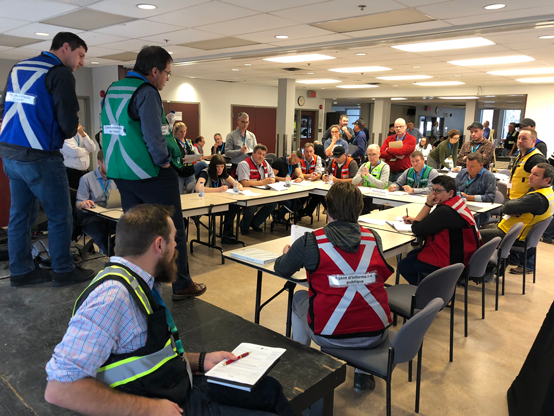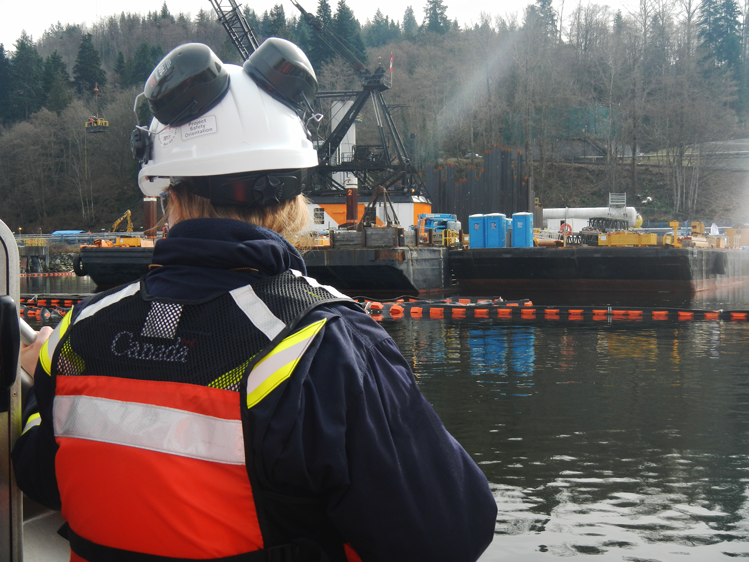Responding to Emergencies
Responding to Emergencies [PDF 3668 KB]
Copyright/Permission to Reproduce
Who is the CER?
The Canada Energy Regulator (CER) oversees how energy moves in Canada. This means keeping watch over companies operating oil and gas pipelines and electrical power lines that cross a national, provincial, or territorial border. The CER’s goal is to see to it that CER-regulated facilities and activities are safe and secure and that the environment is protected throughout their lifecycles.Footnote 1
The CER’s main regulatory responsibilities are defined in the Canadian Energy Regulator Act (CER Act), the Canada Oil and Gas Operations Act (COGOA), and the Oil and Gas Operations Act (OGOA), which is a Northwest Territories statute. The CER also has environmental responsibilities under the Impact Assessment Act and the Mackenzie Valley Resource Management Act. The CER’s emergency management program is comprehensive and includes exercise evaluations, audits, and field response. CER inspectors can also be appointed health and safety officers by the Minister of Labour to administer Part II of the Canada Labour Code as it applies to facilities and activities regulated by the CER.
What are CER-regulated companies responsible for?
Regulated companies are responsible for anticipating, preventing, managing, and mitigating incidents of any size or duration. Companies are required to have a management system that applies to its emergency management program. An emergency management program includes an up-to-date emergency procedures manual,Footnote 2 contingency plans, Footnote 3or both. Manuals and plans must outline the emergency management, environmental protection, and worker and public safety management procedures to be followed during an incident. Companies are also required to implement training and conduct exercises, which are important to develop the coordination needed to respond to incidents. The CER requires companies to post their emergency programs and manuals online for the public.
What happens if an incident occurs?

- The incident is discovered and reported by the CER-regulated company to the appropriate 24-hour incident line:
- the Transportation Safety Board (TSB) incident line for onshore pipelines
- the Spill Report Line for spills from a COGOA or CER Act exploration or production facility (including a pipeline facility) in the Northwest Territories, Nunavut, or in Canadian Arctic waters (out to the Exclusive Economic Zone)
- the Canada Energy Regulator incident line and online event reporting system
- The CER is notified by the TSB or the Spill Report Line.
- The company assesses the severity of the incident and the potential hazards to the public and the environment, and determines appropriate initial actions.
- The CER will determine if the incident is an emergency and decide on an appropriate response based on whether:
- an ongoing threat to people or the environment is present
- there has been an uncontrolled source of release
- it is possible that the effects may escalate further
How does the CER respond when an emergency occurs?
The CER’s priority in any emergency is to make sure that people, property, and the environment are protected.
Any time there is an emergency affecting a CER-regulated energy facility, the CER’s staff will respond, oversee the company’s response, and enforce compliance with regulations that apply. The CER will require that all reasonable actions are taken to protect employees, the public, and the environment. The CER will also verify that the regulated company conducts an adequate and appropriate cleanup and remediation of any environmental effects caused by the incident.
CER emergency response staff are trained to use the Incident Command System (ICS) in order to help manage, coordinate, and control an emergency.
The CER maintains an Emergency Operations Centre (EOC) in Calgary to coordinate its response. This includes updating CER management and Natural Resources Canada, as well as providing situation reports to the Government of Canada’s EOC in Ottawa. The CER’s EOC is also responsible for informing the public of the CER’s actions while responding to an incident.


The CER’s role in an emergency
As the lead federal regulatory agency, the CER:
- monitors, observes, and assesses the overall effectiveness of a company’s emergency response and holds the company accountable for responding appropriately
- confirms that a company is following its emergency procedures manual commitments, plans, and procedures and CER regulations, and identifies non-compliances and potential additional threats
- participates in single or unified command and other roles within the ICS framework (or similar framework if the ICS is not used)
- investigates the event, either together with the Transportation Safety Board, under the Canada Labour Code, or under the CER Act or COGOA (whichever is applicable)
- coordinates post-emergency follow-up meetings with the company to further ensure compliance and to share knowledge obtained during the emergency
- inspects and examines the integrity of the pipeline or facility and verifies that repairs are completed appropriately
- oversees cleanup and approves the restart of the pipeline
- coordinates Indigenous and stakeholderFootnote 4 feedback both during and after the emergency phase
- requires appropriate remediation of contaminated areas
- takes enforcement actions as required



What happens if an inspector finds a problem?
An inspection officer (under the CER Act) or a safety officer (under COGOA) may find that a company is not meeting its commitments or project conditions or may discover a situation that needs to be addressed for safety, security, or environmental reasons.
To resolve the problem, they may:
- address the issue by talking with the company
- issue a notice of non-compliance to the company
- issue an order to the company or anyone involved with the company (either to stop work or to take specific actions)
- refer the issue to the Commission of the CER for consideration and action
When enforcing regulations and conditions, the Commission has flexibility to take any enforcement action necessary. If a company’s operation is a threat to safety, security, or the environment, the Commission can:
- direct that work be stopped
- conduct specific testing or investigation
- require specific remedial action
- implement a pressure restriction
- stop operation, if required, until remedial actions or testing is complete
- issue administrative monetary penalties if warranted
The Commission has the ability to revoke a company’s authorization to operate and can take over a response in specific circumstances.
It is an offence to disregard an order of the Commission or an inspection officer. Such an offence can result in the company, or its officers, being subject to fines or imprisonment.
Working together

The CER has federal, provincial, and territorial partnerships in place for overlapping and adjoining jurisdictions, common regulatory objectives, and the need for effective communication. The CER has several memorandums of understanding in place and continues to develop formal working agreements with its government partners.
The CER makes every effort to work with other agencies and respect overlapping or concurrent jurisdictions.
Integrated approach
During a multi-agency or multi-jurisdictional emergency, the CER participates in unified command as part of an integrated response. Both during and after the emergency phase, the CER will:

- liaise with stakeholders and rights holders and consider their concerns as part of the decision-making process during both the emergency and remediation phase
- use ICS training to integrate into a company’s response as part of unified command and as subject matter experts into other key roles
- proactively communicate to the public when we become aware of an emergency under CER jurisdiction
- review all communication between stakeholders and the company
- confirm that the company continues to communicate with stakeholders and address their concerns
- gather stakeholder comments and concerns about the initial clean-up plan, remedial action plan, and remediation closure report and give these to the company to address
The CER and the Transportation Safety Board
The CER is the lead federal regulatory agency for all incidents that occur on CER-regulated facilities or activities. The TSB may investigate an incident on a CER-regulated pipeline. For these incidents, the TSB is the agency responsible for determining the cause and contributing factors leading to the incident. The TSB issues a public report once it concludes its investigation.
During a TSB investigation, the CER conducts concurrent and co-operative analysis and regulatory oversight activities to determine factors relating to regulatory compliance, industry trends, and actions necessary to prevent similar occurrences. The CER will determine whether the company involved in the incident should put additional remedial measures in place. The CER will also make a decision on whether further action should also be taken by all CER-regulated companies to prevent similar incidents from happening again.
Contact the CER
Contact the CER for more information on the CER’s emergency management program:
Email: BUOPS.EMS-GMUS@cer-rec.gc.ca
Call: 1-800-899-1265 (toll free)
Find out more
Find out more about the Canada Energy Regulator
by visiting us online.
Be sure to follow us on social media for the latest updates.
For copies of any CER publication or for more information, contact us:
ONLINE: www.cer-rec.gc.ca
EMAIL: info@cer-rec.gc.ca
TOLL FREE: 1-800-899-1265
Write us or visit our library at:
Canada Energy Regulator
210-517 10 Ave SW
Calgary AB T2R 0A8
- Date modified:
